Central Grasslands Forum - Winter 2020
A Walk through the Pasture
Kevin Sedivec, Interim Director, CGREC
The Central Grasslands Research Extension Center experienced a great growing season environment in 2019 for grassland production and grazing. Rainfall was only slightly above normal in May through September (112% of normal); however, conditions became wet and cool in October and November (206% of normal).
Like most farmers in the state, we were able to harvest only one of our three corn fields, and we took that one as high-moisture corn to feed this winter. A second field also was too wet to harvest and store, so we turned out 375 bred cows in a 40-acre field to harvest using a lower input strategy - graze. Our third corn field will stay standing until late winter and then we’ll harvest for grain, hoping for lower moisture levels.
I was a bit nervous grazing our entire mature beef cow herd on standing corn that was holding 140 bushels per acre. Plus, with the snow in the corn, we decide to not strip graze and give the cows the entire 360-acre field (the 40 acres standing corn, 40 acres harvested corn, 240 acres grass/alfalfa hay and 20 acres wetlands).
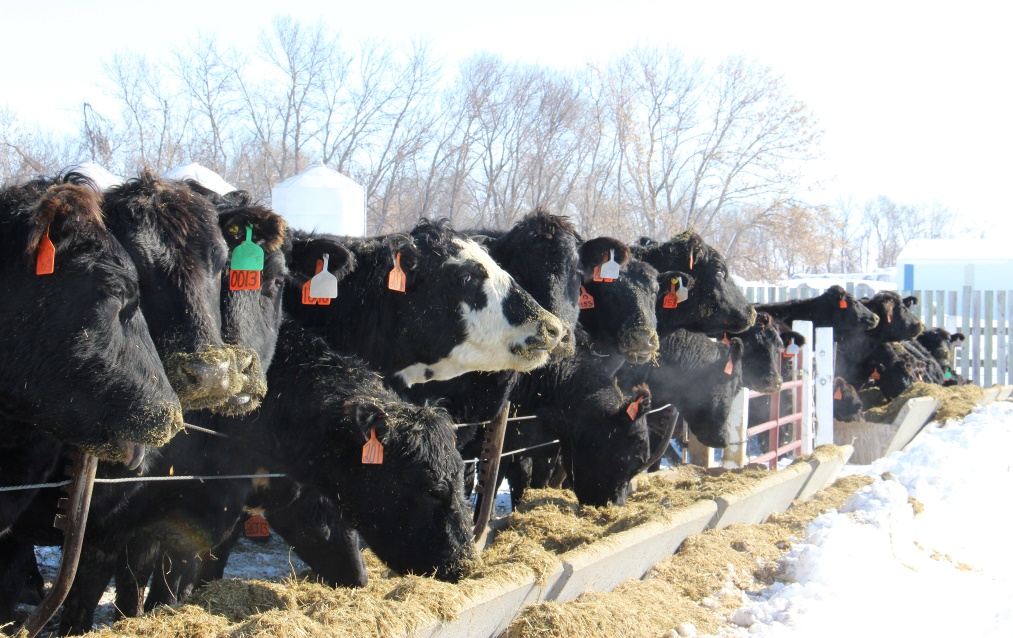
Our herdsman, Tim Long, started feeding the cows whole corn 10 days prior to turnout at 2 pounds/day and increasing to 10 pounds/day on the last day. He also added higher levels of calcium in their diet to offset the low calcium content of corn and provide a pH buffer.
On the last day prior to turnout, we filled their rumens with hay in the morning and turned them out – this was about Dec. 3. The cows are still out grazing corn and crop aftermath - with a high calcium supplement - as I write this article (Jan. 21), with no animals sick and all doing well.
We started a few new trials in 2019. Miranda Meehan, NDSU Extension environmental stewardship specialist, is lead principal investigator on a North Central Sustainable Agriculture Research and Education project that will study full-season cover crop grazing on soil health, forage production, livestock performance and economic return from the land.
This project involves six farmers/ranchers, six Extension agents, five state Extension specialist, the Main Station livestock unit and the center. Michael Undi, Erin Gaugler, Scott Alm and I will lead the center’s portion of the project that also includes testing winter cereal forage crops – winter rye, winter wheat and winter triticale – on forage production and livestock performance when grazed the following spring.
The full-season cover crop will be seeded after heifers graze the winter cereals from mid-May to mid-June. We will start grazing the cover crop in late July using strip grazing and rotational grazing treatments and compare them with an unharvested treatment. This project will be repeated in 2021 and 2022.
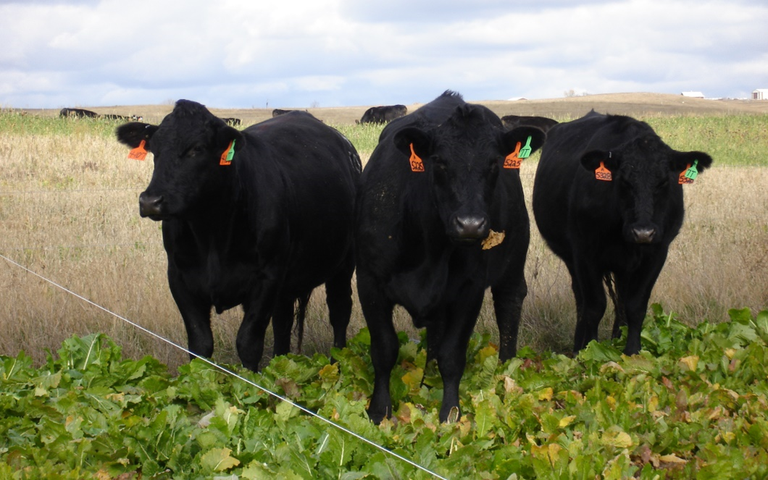
The other new projects include 1) quantify the amount of regrowth – and subsequent cumulative growth – of rangelands following a) a spring prescribed fire with 14, 28 and 42 days grazing recover and b) a rotational grazing with 33, 59 and 76 days grazing recover at different disappearance levels (led by Erin Gaugler and me); 2) trans-generational programming of beef cattle under different nutritional and mineral programs (lead by Carl Dahlen, Rika Baumgartner and me); 3) forage production and quality of select varieties of forage oats, forage barley and spring triticale (lead by Scott Alm) and 4) compare winter survival, forage production, soil health and livestock performance of winter rye, winter wheat and winter triticale (lead by Scott Alm, Michael Undi, Erin Gaugler and me).
The center had the privilege of hosting five tours this summer, with 196 people getting a chance to see our research projects “in action.” We had the National Rangeland Partnership team visit in May, with people from as far away as Hawaii on the tour.
In July, we held our annual field day, and in August, we hosted a group of people associated with the International American Grasslands Conference, which had people from Canada and Mexico on the tour. In September, we hosted the Angus Select Sire northern tour and the North Dakota Chapter of the Society for Range Management.
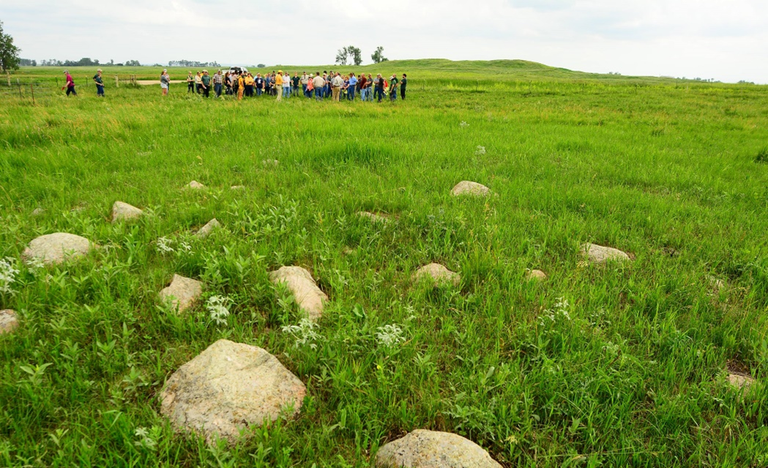
In closing, summer was good to the center with ample moisture, but fall was too wet and cool to get all harvesting complete. The winter has started out kind of brutally, with a lot of snow (about 60 inches so far) and cold days plentiful. Spring will be slow to come, but the start of calving season is only two months away.
If you ever have any advice or just want to visit about the research and Extension programs conducted at the Central Grasslands Research Extension Center, drop me an email (kevin.sedivec@ndsu.edu) or give me a call (701-799-4689).
Until our next walk through the pasture, stay warm, keep your animals protected and attend some good workshops to continue learning. Take time to enjoy your family and take a walk on those warm, sunny days when they come.
Photos by Sandi Dewald and Bryan Neville, NDSU
Tips and Tools for Signing Up for Farm Bill Programs
Penny Nester, Agriculture and Natural Resources Agent, NDSU Extension – Kidder County
The new farm bill has a lot of similarities to the 2014 bill; however, the new bill has a few changes that everyone needs to be aware of to make the best choices for their operation on an annual basis.
First, the options available are the same as in the previous farm bill: Price Loss Coverage (PLC), Agricultural Revenue Coverage - County (ARC-CO) and Agricultural Revenue Coverage - Individual Coverage (ARC-IC).
PLC program payments are issues when the effective price of a covered commodity is less than the respective reference price for that commodity. The effective price equals the higher of the market year average (MYA) price or the national average loan rate for the covered commodity.
ARC-CO uses county yields of crops for which the farm has base acres, regardless of what actually is planted on the farm. It provides income support tied to historical base acres, not current production, of covered commodities. ARC-CO payments are issues when the actual county crop revenue of a commodity is less than the guarantee for the crop.
The ARC-IC payment rate is determined by a weighted average of all covered commodities grown on the enrolled farm or farms. In some instances, it may be less likely to trigger a payment because strong revenue of some crops may offset weak revenue of other crops.
All three programs, ARC-CO, ARC-IC and PLC, rely on national average marketing year prices in payment calculations.
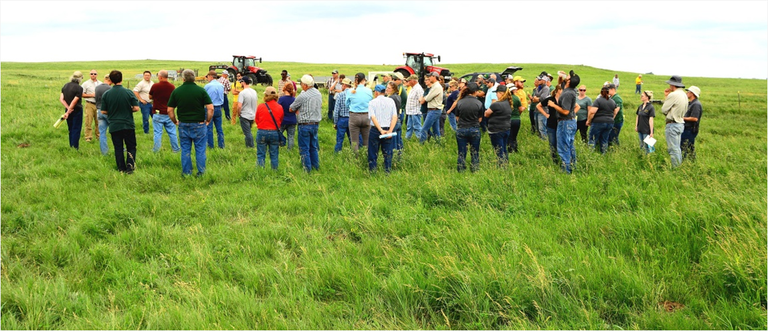
What has changed under the 2018 farm bill compared with the 2014 farm bill?
- Producers may elect for ARC or PLC by covered commodity or ARC-IC for 2019 and 2020 and re-elect each year thereafter through 2023.
- Producers have a one-time opportunity to update PLC program payment yields that take effect beginning with the 2020 crop year.
- The effective reference price replaces the reference price for calculating benchmark revenues under ARC and payment rates per unit under PLC.
- ARC-CO yields are based on data from the Risk Management Agency rather than data from the National Agricultural Statistics Service. ARC-CO yields are trend adjusted.
- Base acres on farms where all cropland acres have been planted to grass or pasture, including cropland that was idle or fallow from Jan. 1, 2009, through Dec. 31, 2017, will be maintained but ineligible for ARC and PLC payments from 2019 through 2023.
- The effective reference price, ARC-CO benchmark yields and ARC-CO benchmark price calculations are based on a one-year lag (for example, for program year 2019, crop years 2013-2017 will be used to calculate the effective reference price, ARC-CO benchmark yields and ARC-CO benchmark prices, and ARC-IC).
The 2019 enrollment deadline is March 15, and the 2020 enrollment deadline is June 30, 2020. If no election is made for 2019 by March 15, 2020, for ARC (County or Individual) or PLC, the election defaults to the current election on the farm from the 2014 through 2018 program years. Also, no payments will be made for 2019.
So for what program should I sign up my farms? NDSU Extension has several tools to plug in your farm numbers and determine your potential payments with the different programs using the most current information available. The easiest option is to make an appointment with your local Extension agent and bring in your 156-EZ form from your Farm Service Agency office. The agent can provide you with an estimate on different programs payouts.
If you want to enter in the numbers yourself and see what does and does not trigger a payment for your farms, several Excel calculators are available at www.ag.ndsu.edu/farmmanagement/farm-bill.
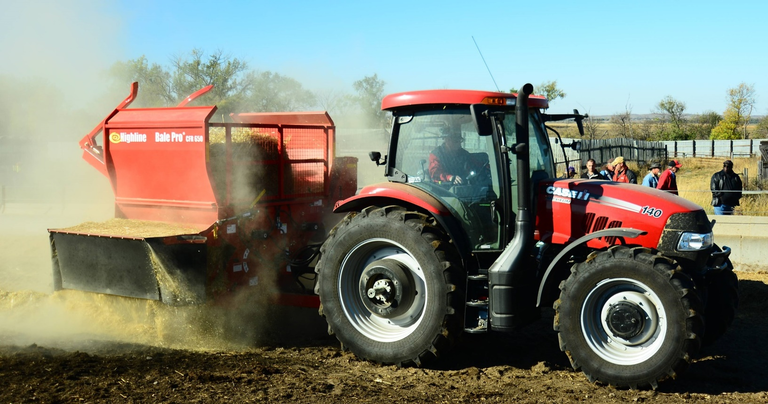
Photos by NDSU-CGREC
Corn Stalk Residue Grazing Impacts on Soil Health and Crop Production
Justin Leier, CGREC Farm Technician
During the late fall, seeing cattle grazing corn stalks is common. This can be a highly economical way to feed cattle while also removing excess plant material left behind.
When grazing cattle on corn stalks, producers have a number of agronomic factors to consider. Grazing may have benefits to some aspects but also could hurt the field in other agronomic aspects. A producer should consider how grazing cattle could affect soil compaction, organic matter (OM) content, microbial activity levels, fertility, pH and yield.
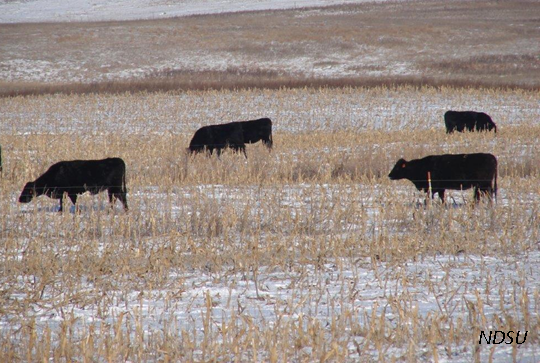
Long-term studies performed in North Dakota (six years) and Nebraska (16 years) have found small bulk density increases of 0.08-0.12 gram per centimeter (g/cm3) with residue grazing, which was not enough to reduce root growth.
The increases in bulk density were greater when fields were grazed in the spring than in the fall. This occurred because the frozen ground prevented compaction during the fall and winter, while the thawed, wet spring ground was more conducive to compaction.
Organic matter is not significantly affected due to the low level of residue removal and the cycling of organic matter through cattle and back to the field.
Cattle manure is a high-quality fertilizer, so grazing cattle on corn stalks has the potential to increase the fertility of the field. In those North Dakota and Nebraska studies, nitrogen, phosphorous, calcium and sulfur were found to show small but significant increases after multiple years of grazing. In one North Dakota study, pH was significantly decreased, but in other studies, grazing had no effect on soil pH.
Grazing had a positive effect on crop yield, increasing soybean yield by 3.4 bushels/acre, or had no effect. Overall, when grazed at recommended stocking rates, cattle grazing residue had a neutral effect on cropland in most aspects of soil health but may have some positive effects as well. More long-term studies specifically on corn grazing in North Dakota are needed for a more accurate perspective on the effects of this practice in our state.
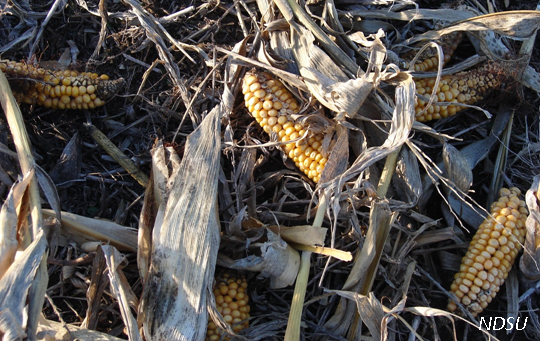
Fall of 2019 was Challenging: Lessons Learned
Scott Alm, CGREC Manager of Farm Operations
The fall of 2019 brought harvesting challenges for producers in North Dakota. A snowstorm in October followed by intermittent rains prevented timely harvest.
Going into 2020, the U.S. Department of Agriculture estimated that less than 50% of corn has been harvested in North Dakota. Even the corn that was harvested was wet and needed drying.
At the center, we were able to harvest only one of our three corn fields, and we took that one as high-moisture corn to feed this winter. A second field also was too wet to harvest and store.
When we think of the word “growing,” some might think of their kids growing up to be adults, and some might think of growing their crops or cattle to be successful. Whatever perspective you choose, an immense amount of growing occurred in 2019.
I don’t need to tell anyone reading this article that 2019 was a tough year for agriculture, but it’s what we’ve learned or how we’ve grown from the experience that will define the future years and generations.
Maybe integrating cover crops to maximize wet areas or integrating cattle to graze residue was something new. Do we have areas in which we could improve our planning to make the best of a bad situation? I encourage all who have endured this growing season to take a moment to reflect on how they have grown this year and look forward to using that experience in the future.
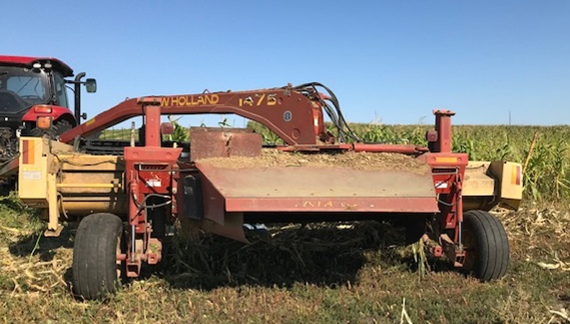
Meet Tim Long, CGREC Herdsman
 My name is Tim Long, I’m taking this opportunity to introduce myself.
My name is Tim Long, I’m taking this opportunity to introduce myself.
I was raised on a beef, dairy and small-grains farm near Berlin, N.D. After graduating from high school in Edgeley, N.D., I attended NDSU, majoring in Ag Econ and Animal Science.
I spent the next 30 years of my working career in the feed business in sales, nutrition consulting and territory management in the upper Midwest. Starting in March of 2018, I became the beef herdsman at the CGREC. The good cows and great co-workers are making this a wonderful job.
My wife, Lisa, is the business manager for SCPSEU in Napoleon. We have a cow-calf hobby farm near Kintyre, N.D., where we “raised” three children (Jessica, Katelyn and Tyler). I say “raised” because the youngest graduated last spring.
We are always open to visitors at the CGREC. If anyone is interested in the ongoing research projects we are conducting on range and livestock, please give us a call. We are more than happy to show you around and share any useful information.
Meet Justin Leier, CGREC Farm Technician
 I grew up on a farm and ranch near Napoleon, N.D., where we raised cattle, sheep and pigs. We grew a vast array of crops, including many annual forage crops. I was highly involved in FFA while I attended Napoleon High School.
I grew up on a farm and ranch near Napoleon, N.D., where we raised cattle, sheep and pigs. We grew a vast array of crops, including many annual forage crops. I was highly involved in FFA while I attended Napoleon High School.
In December 2017, I graduated from NDSU with a bachelor’s degree in crop and weed sciences. During my time at NDSU, I spent the summers interning with Monsanto, Bayer Crop Science and Dow AgroSciences in various crop science disciplines. In October 2019, I completed a master’s degree in plant sciences, working on hybrid wheat under the direction of Andrew Green.
I have always enjoyed working with livestock and putting up hay, so I am very excited to be here. With my experience in crop research, I hope to greatly increase the amount of forage research conducted at the center.
I hold a special interest in annual and winter annual forages such as rye, winter peas and oats, and determining the feeding qualities, varietal differences, and optimal agronomic practices and crop rotations. I also look forward to conducting valuable research on perennial forages, cover crops and intercropping systems.
Upcoming Events
Feb 25 - 26: Farming and Ranching for the Bottom Line Conference at Bismarck State College. Contact the North Dakota Grazing Lands Coalition (contact@ndglc) for more information.
Late July: CGREC Annual Field Day 4 to 7 pm
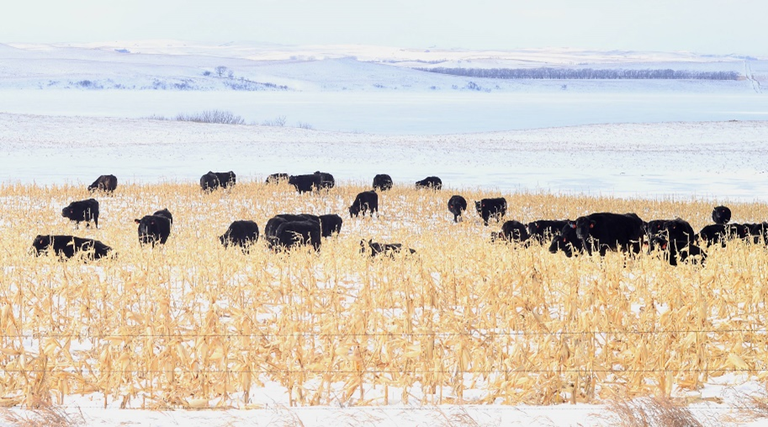
Central Grasslands Forum - Winter 2020



